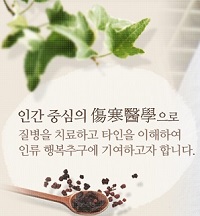수면 장애 환자를 통한 『傷寒論』 陰陽易差後勞復病에 대한 고찰과 DSM-5 수면-각성 장애와의 연관성
Analyzing Eumyangyeokchahunobok-byung(陰陽易差後勞復病) based on cases report and its association with DSM-5 sleep-wake disorder
이성준 (정인한의원)
Abstract
Objective : To explore the meaning of Eumyangyeokchahunobok-byung (陰陽易差後勞復病) through two cases and finding the relationship with the DSM-5 sleep-wake disorder. Methods : Following a disease pattern identification diagnostic system based on Shanghanlun provisions (DPIDS), we analyzed cases with chronic fatigue and diplopia caused after sleep disorders. The patients were treated with the Soshiho-tang and Yijoong-tang. Results : The two herbal medicines showed remarkable improvement in the patients. The sleep disorders and the secondary pathologies were rapidly relieved within a month. Conclusions : The patterns of sleep disorders of the two patients were found to be very similar to the circadian rhythm sleep-wake disorders, as described in DSM-5. Although the etymology of the Chinese characters has not been clearly known yet, it was possible to present the original hypotheses on 更and 了due to clinical inference.
- keywords
- 陰陽易差後勞復病, Sleep Disorders, Chronic Fatigue, Diplopia, Soshiho-tang, Yijoong-tang, Shanghanlun
참고문헌
1. Foley DJ, Monjan AA, Brown SL, Simonsick EM, Wallace RB, Blazer DG. Sleep complaints among elderly persons:an epidemiologic study of three communities. Sleep. 1995;18:425-32.
2. Oh JE. Sleep disorders in the elderly. Korean J Clin Geri. 2015;16(2):37-43.
3. Jeong SY, Kim JY, Kho YT, Ahn KS, Lee CR. Oriental Medical Treatment Pattern of Korean Patients with Sleep Disorders. J of Oriental Neuropsychiatry. 2014;25 (4):389-400.
4. Chilcott LA, Shapiro CM. The socioeconomic impact of insomnia:An overview. Pharmacoeconomics. 1996;10(1):1-14.
5. Na ID, Park MS, Kim YM. The study on korean medical pattern differentiation of sleep-wake disorders by DSM-Ⅴclassification. J Physiol & Pathol Korean Med. 2017;31(2):83-93.
6. Kim SU, Jung HJ. A study on treatment of sleep disturbance in the books on cold damage. The Journal of Korean Medical History. 2014;27(2):99-120.
7. Jung JH, Ha JW, Kim BK. The current status about sleep disorder in the Journal of Oriental Neuropsychia -try for evidence based medicine. J of Oriental Neuropsychiatry 2012;23(4):11-36.
8. Cho SH, Lee SJ. 4 Case reports of Eumyangyeokchahunobok-byung treated by herbal medicine based on Shanghanlun provisions. Journal of Korean Medical Association of Clinical Sanghan-Geumgwe. 2016;8(1):121-43.
9. Kim DD. A case report of panic disorder treated by Jukyeopseokgo-tang based on Shanghanlun provisions. Journal of Korean Medical Association of Clinical Sanghan-Geumgwe. 2016;8(1):155-64.
10. Lee SI. A philological research on the way of medical study of Shanghanlun. Official Journal of The Korean Medicine Society For The Herbal Formula Study. 2014;22(2):1-13.
11. Park KM, Choi SH. The comparative study of 『Sanghanron』 and 『hwangjenaegyeong』 through historical study on 『Gangpyung·Sanghanron』. J. Korean Medical Classics. 1995;9:263-300.
12. Moon KS. A study on the classification of the misinterpretations about chinese bronze characters. Journal of regional culture research. 2013;12:181-218.
13. Koo BM, Yang JC, Kim SK, Lee KY, Kim JY. A clinical study about the effects of Soshiho-tang on a case of Parkinson's disease with pontine infarction. J Korean Oriental Med. 2007;28(2):34-43.
14. Kim SB, Jeong YK, Lee HG, Mun SK, Jung WS, Cho KH. A case of central fever patient diagnosed as pontine hemorrhage treated with Soshiho-tang. The Journal of the Society of Stroke on Korean Medicine. 2016;17(1):1-8.
15. Noh HM, Park SG, Park IH, Jo EH, Park MC. Two cases of atopic dermatitis with gastrointestinal disorders treated with Soshiho-tang. J Korean Med Ophthalmol Otolaryngol Dermatol. 2016;29(3):208-16.
16. Yim JM, Lee SM, Kim WI. A case report on nausea, retching, vomiting and postprandial fullness treated with Soshiho-tang. Official J of the Korean Medicine Society for the Herbal Formula Study. 2013;21(2):158-64.
17. Baik YS. A study on the complex efficacy of Soshiho-tang. J Korean Medical Classics. 2014;27(2):137-52.
18. Lee LC, Lee JB. A case report of taeyang-byeong nausea patient with Soshiho-tang. Journal of Korean Medical Association of Clinical Sanghan-Geumgwe. 2013;5(1):53-9.
19. Lim EK. A case report of obesity treated with Soshiho-tang gagambang based on Shanghanlun provisions. Journal of Korean Medical Association of Clinical Sanghan-Geumgwe. 2015;7(1):65-73.
20. Ryu HC, Lee SI. A case report of chronic cough treated by Soshiho-tang based on Shanghanlun provisions. Journal of Korean Medical Association of Clinical Sanghan-Geumgwe. 2016;8(1):99-108.
21. Min JH, Jo SH. A case report of atopic dermatitis treated by Soshiho-tang based on Shanghanlun provisions. Journal of Korean Medical Association of Clinical Sanghan-Geumgwe. 2015;7(1):75-85.
22. Park JK. A case report of menopausal syndrome treated by herbal medicine based on Shanghanlun provisions. Journal of Korean Medical Association of Clinical Sanghan-Geumgwe. 2016;8(1):87-97.
23. Park SY, Lee SJ. A case report of pitting edema treated by Soshiho-tang based on Shanghanlun provisions. Journal of Korean Medical Association of Clinical Sanghan-Geumgwe. 2017;9(1):37-45.
24. Park JK. Adverse drug reactions of patient with cervical spondylotic myelopathy treated by Soshiho-tang. Journal of Korean Medical Association of Clinical Sanghan-Geu -mgwe. 2017;9(1):47-58.
25. Ryu SH, Roh GH, Choi DJ, Kim YS, Lee KS. A clinical report of the stroke patient with diarrhea improved by Yijoong-tang. J of Oriental Chronic disease. 2000;6(1):121-6.
26. Lee SJ, Lim JE. A diagnostic system and clinical application based on Shanghanlun six meridian patterns and provisions. Seoul:Kmediacs publishing house. 2014:1-6.
27. Ha YS. The Dictionary of chinese character's origin. Seoul. 3-Publication. 2014;235,244.
- 다운로드 수
- 조회수
- 0KCI 피인용수
- 0WOS 피인용수


